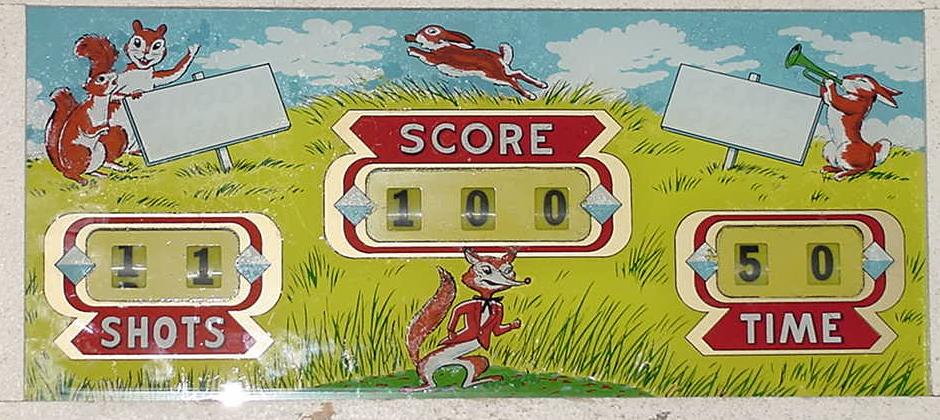
|
Description: SharpShooter, Bally, 1/61, shoots hard solid plastic 11/16" balls using a "blower" vacum system, hitting individual targets that move back and forth and that fold back when hit (the targets are essentially metal pinball drop targets). Cabinet dimensions are 67" long by 45" tall by 25" wide. Sharp Shooter has four rabbit targets (stationary, 10 points each), three large squirrels (constantly moving left to right, 10 points each), three small squirrels (constantly moving left to right, 20 points each), and one fox (moves back and forth switching direction randomly during the second half of the game, 40 points). The game is timed (operator selectable for 40 or 50), but the player gets 20 shots minimum. If the timer get to 40 or 50 and there are less than 20 shots made, the player can take as much time as desired to shot their 20 shots. If the player shoots quickly, more than 20 shots can be made in the given time (game ends when the timer gets to 40 or 50). The game is capable is shooting about one shot per second. The timer is incremented each time a switch is closed on the squirrel track (the six squirrel targets are on a bicycle chain which moves using a motor), which happens slightly faster than once per second. If the player gets enough points (operator selectable from 500 to 800 points), a free game is awarded. The power behind the gun is generated by a shop vac type system. The "suck" on the shop vac sucks the balls from the back of the game, and brings them to a loading mechanism under the shop vac guts. Then the "blow" on the shop vac propels the balls through the gun. It works pretty well really. The only catch is the shop vac and all the associated tubing needs to be clean, and with tight fittings (to avoid leaks). Also the inside of the game needs to be kept sparkling clean (otherwise the shop vac will suck all the dirt into the ball tubing, and slow the balls). Note it's not the "suck" portion of the shop vac that propels the ball. So leaks in the ball feed tubing, and around the black cardboard shell, and around the black cardboard shell feed to the copper tubing really doesn't matter (there just needs to be enough "suck" get feed the balls). It's the shop vac's exhaust, the "blow", which pushes the balls. And the only tubing here is the flexible tube from the copper to the gun. Note the ball feed tubing seems to be the same semi-rigid tubing as used in underground lawn sprinkler systems. Bally's Sharp Shooter is very similar to the other projectile gun games like the Midway Shooting Gallery (9/60) and Deluxe Shooting Gallery (3/61) and White Lighting (9/70). Also Bally came out with another air-powered gun game called Marksman (5/61). Marksmen is almost identical to Sharpshooter, except it had updated non-chip plastic targets (Sharpshooter's targets were a thick bakelite material). But of the air-powered gun games, the Bally Sharp Shooter and Marksmen are probably the best. The moving animals, score reels for shots/time/score, and the classic early 1960s styling (dinette legs!) make this a decently atttractive and very fun game (though the Midway White Lightning is a close second, but the targets moving in a circle are less "shooting gallery classic" in my eye). The game uses standard solenoid driven score reels with yellow plastic reels. The reels themselves are smaller in size than what was used by Williams and Gottlieb. Note these reels can ONLY be "dry cleaned" with a soft cloth. Do *not* use anything wet (not even Novus2) to clean the reels! The ink will come right off. Sharp Shooter has glass side panels, but the cut front panel that goes around the gun is plexiglass. The 3/16" thick side glass panels are a strange size: 20" wide by 43.5" long on the bottom side, and 42.5" long on the top side. There are two right angles against one 20" side (so only the front edge of the side glass closest to the gun is angled). Also this game uses tubular dinette style legs. Some graphics for the game are also available. On the game I was restoring, the right side "tree" graphic was missing. So using the left side tree, I recreated both trees. The file is in PhotoShop 6.0 format and are at 300 dpi, and can be printed using this software. Download the trees here (23 meg, WinZIP format, Pantone color corrected). The animal targets (small and large squirrels, rabbits, fox) were also recreated using PhotoShop 6.0 at 300 dpi, and are available for download here (2 meg, WinZIP format, Pantone color corrected). Also the background behind the drop target rabbits on my game was extremely warped, making the drop target reset function not work. To repair this, I had to replace this entire background panel with a new Lexan (polycarbonate) 21.5" x 9 3/8" x 3/16" thick panel. And of course the graphics had to be reproduced for this panel too. Download the rabbit background here (22 meg, WinZIP format, Pantone color corrected). Also the score cards are available here (1meg, scanned at 300dpi, small card is 3 3/8" by 7/8", large card is 5" x 2 3/8"). Regarding the balls used for ammo in the game. These are NYLON, yellow colored with speckles, hard solid plastic with good bounce properties. The original balls measured from .660" to .670" (some balls chipped!) in the game I have, which probably have shrunk from the original 11/16 (.6875") size. The gun barrel's inside diameter measure at .6950", so a 11/16" (.6875") ball should be used. New 11/16" balls are the ticket for this game. They shot faster and straighter as there is less compression loss around the balls when they shoot through the gun barrel. Using the original balls was not as good, as the gun was not very accurate. That was always the complaint with this game amoung collectors, but new balls changes that attitude immediately (as I have found in so many other types of games, bowlers like Midget Alley in particular, new balls make all the difference in accurate game play). New 11/16" polished nylon balls are available from Salem Ball Company, 1-877-844-4885 (no minimum order, $2.50 each). As for the number of balls, my game had 12 original balls in it, and I'm pretty sure that is the correct number. Unfortunately the parts list for this game and White Lightning does not specify the number of balls or sized used. The game does seem to work fine with ten balls though.
|
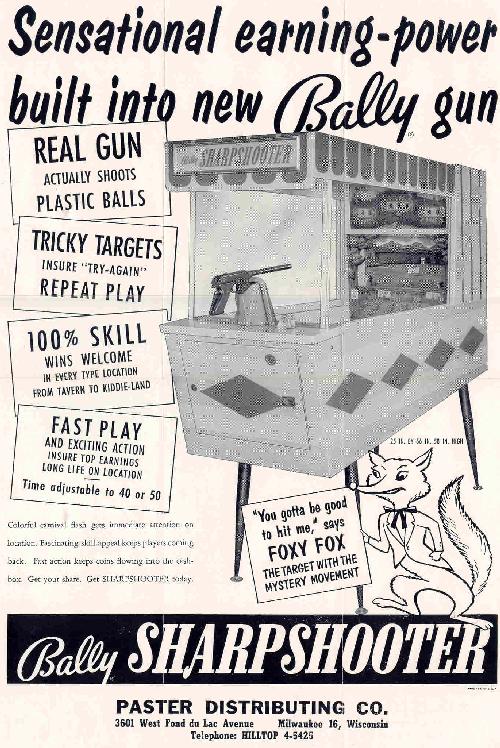
Two different backglass styles!

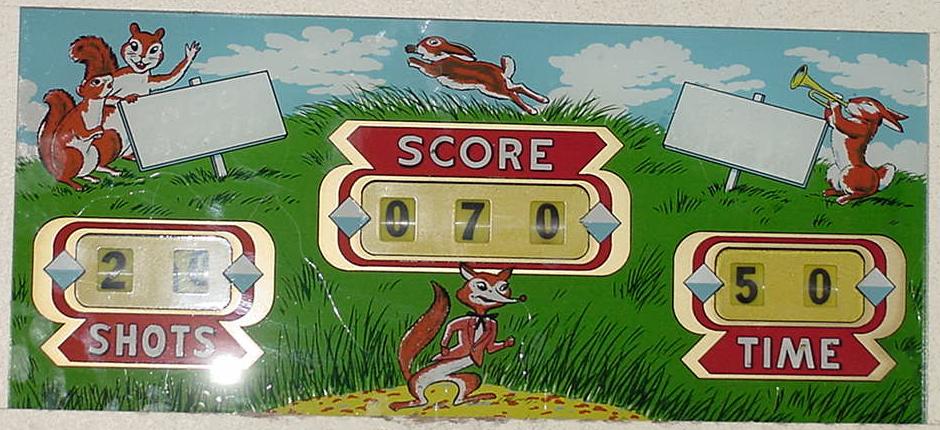
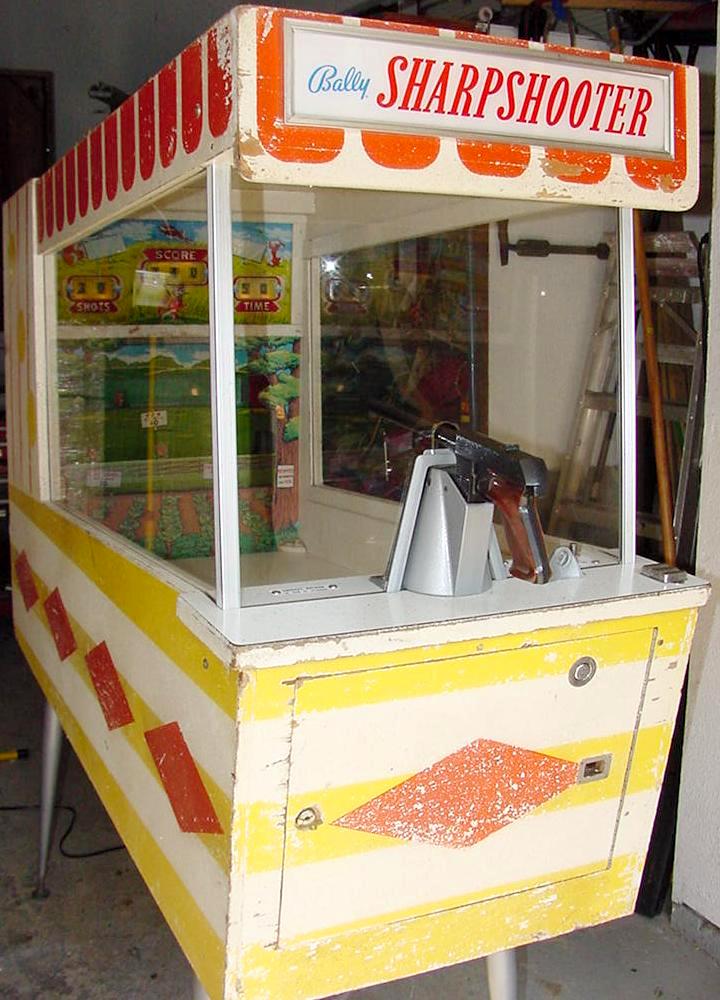
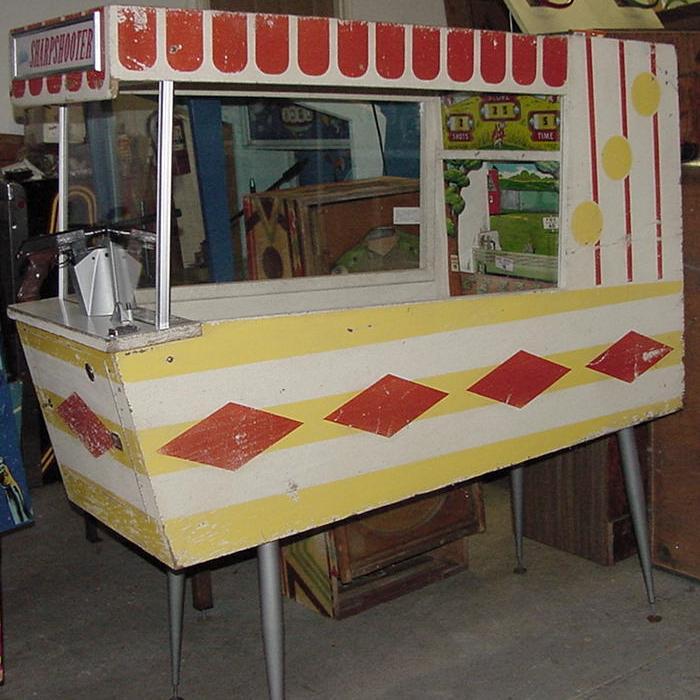
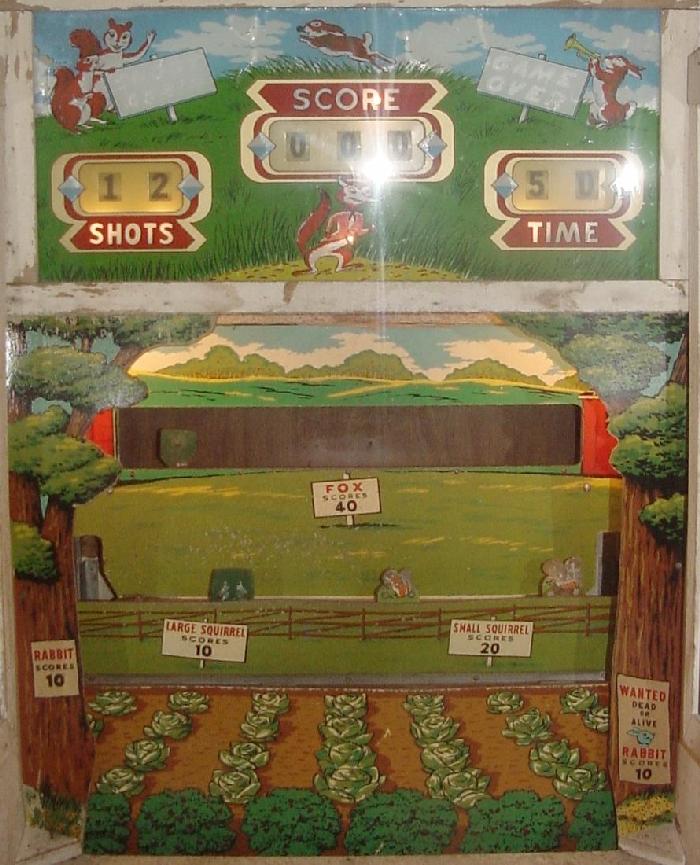
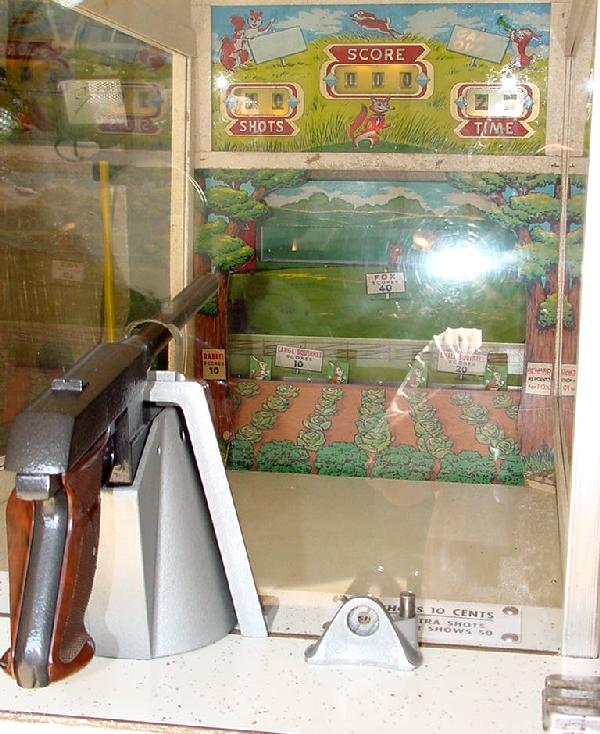

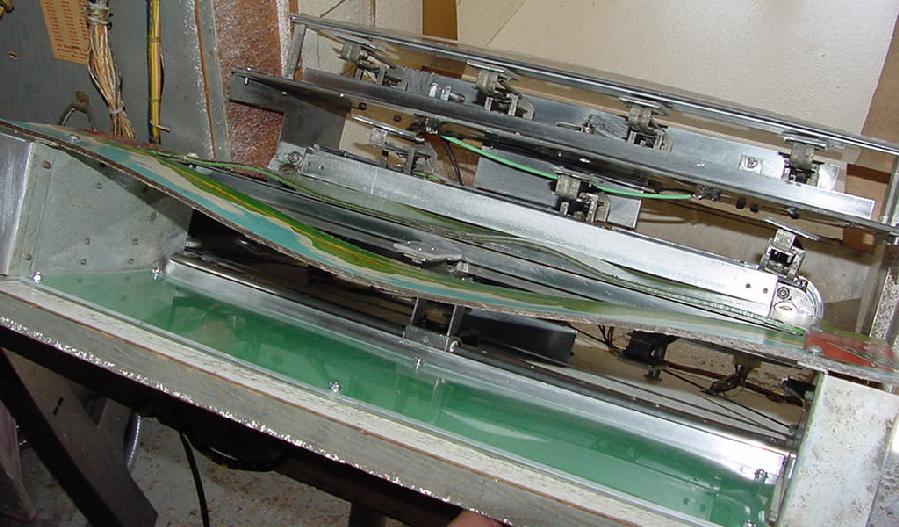
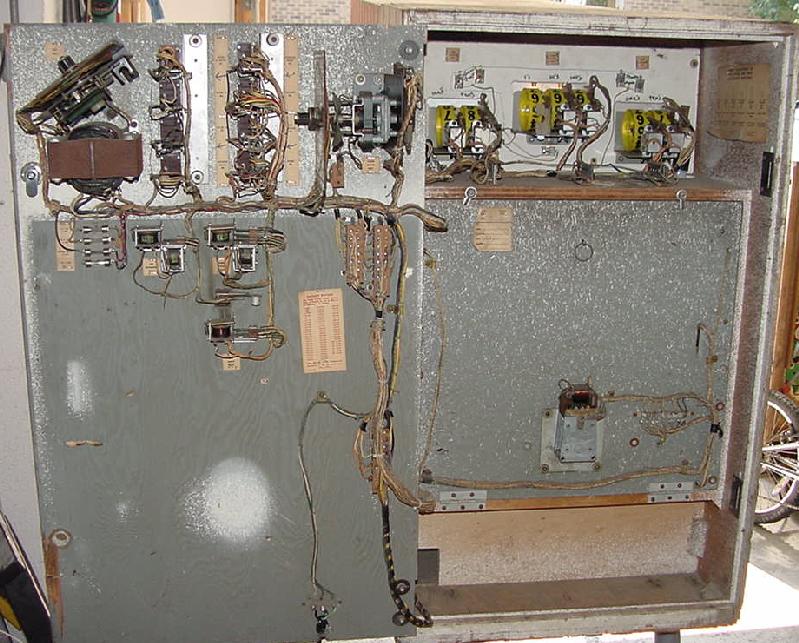
The "shop vac" and ball feed solenoid components:
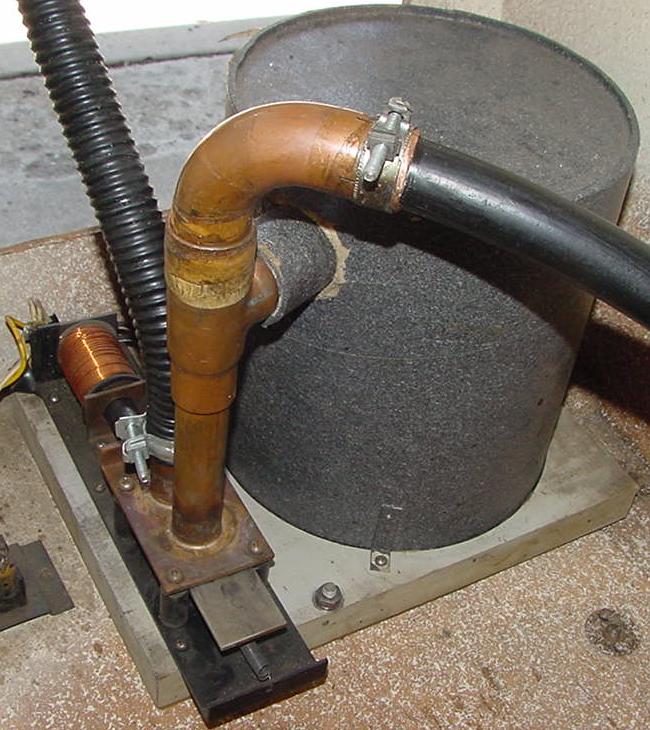
The "shop vac" with it's black cardboard shell removed, and ball feed mechanism disassembled:
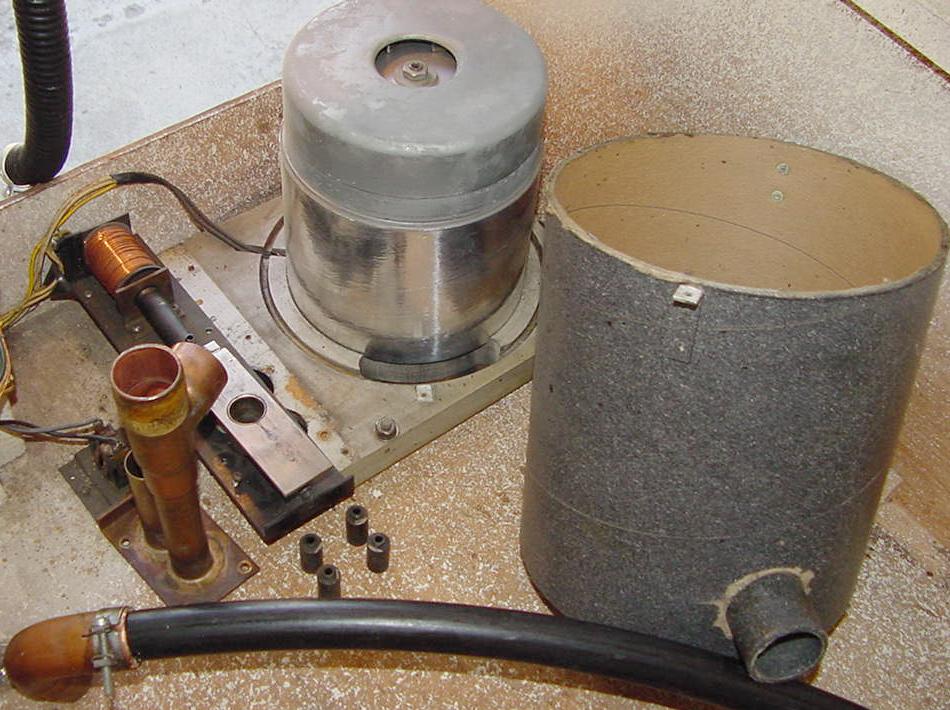
The underside of the "shop vac" and the wooden base it rests on.
Note the two holes on the left, the oblong channel at the bottom,
and the large center hole under the shop vac for the balls to feed.
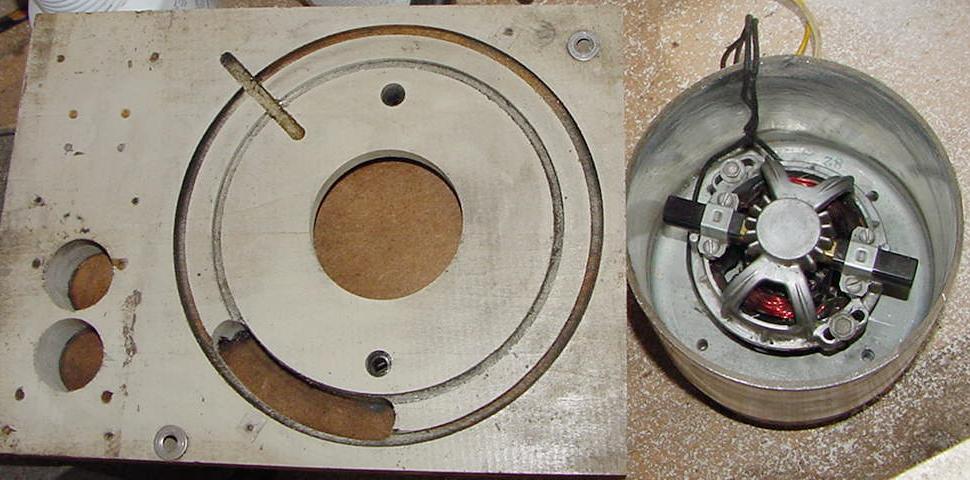
|
* Email the collector cfh@provide.net * Go to the EM Arcade History index * Go to the Pinball Repair/History index |